Top 15+ Temple near Hoi An you must visit
Escape the bustle of Hoi An and find serenity among the town’s most beautiful temples near Hoi An. These peaceful pagodas and sacred sites offer quiet corners for reflection, meditation, and a deeper connection to the local culture. From ornate halls to shaded courtyards, each temple provides a calm retreat, allowing travelers to slow down, absorb the spiritual ambiance, and appreciate the timeless beauty and traditions that make Hoi An truly unforgettable.
Top 15 temple near Hoi An
Discover the most iconic and hidden temple near Hoi An, each offering a unique glimpse into the town’s history, culture, and spiritual heritage. From well-known landmarks to peaceful pagodas tucked away in quiet corners, these 15 temples provide a memorable journey for travelers seeking culture, reflection, and serene experiences.
Japanese Covered Bridge
The Japanese Covered Bridge, or Chùa Cầu, is undoubtedly one of Hoi An’s most iconic landmarks, located on Thanh Ha Street in Hoi An Ancient Town. Built in the early 17th century by the Japanese community, the bridge originally connected the Japanese quarter with the Chinese district.
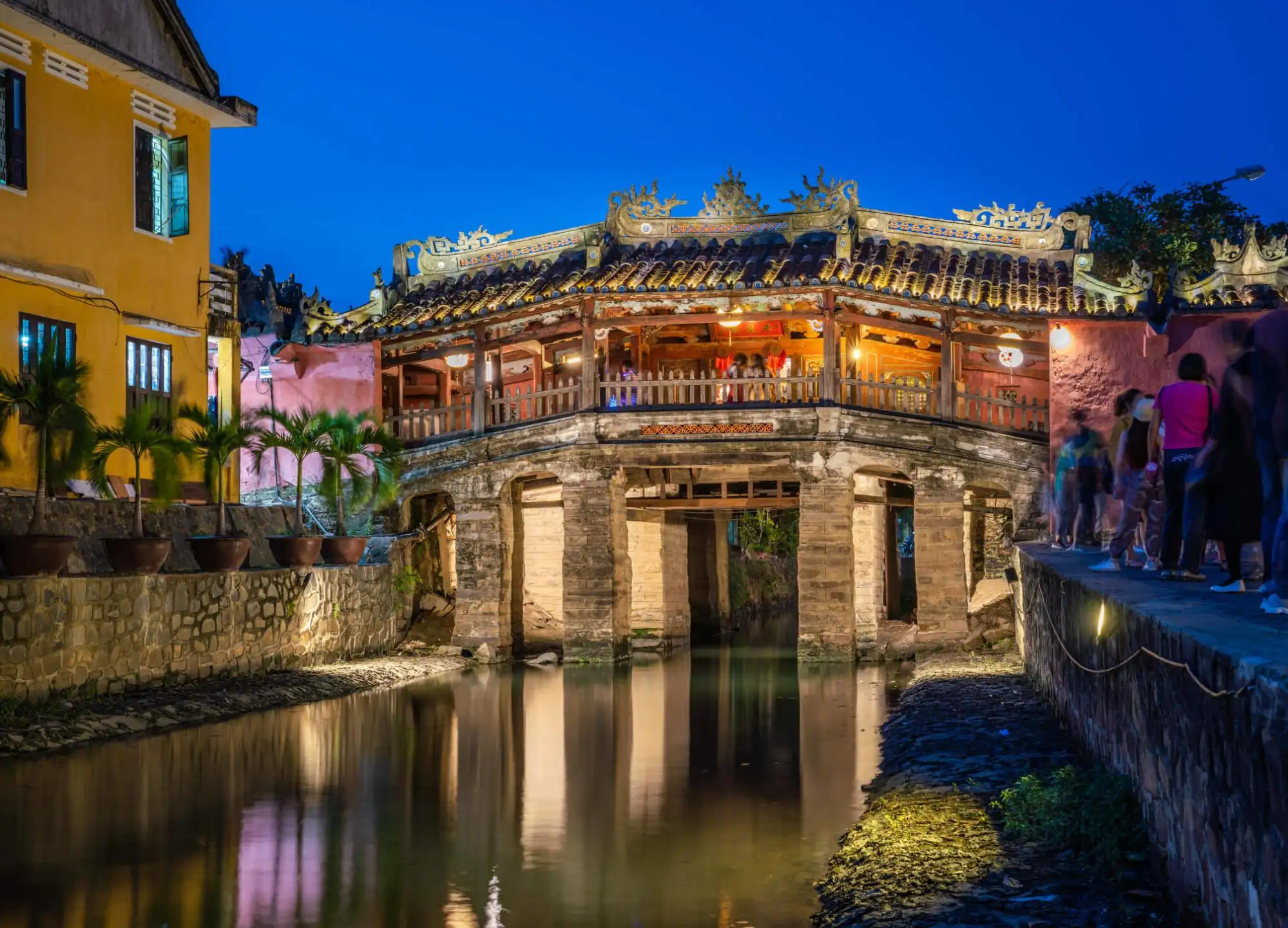
Its distinctive arched roof, intricately carved wooden beams, and the tiny temple dedicated to the Taoist deity Tran Vo in the middle make it architecturally unique, earning its place as one of the must-visit temples near Hoi An. Visitors can easily reach the bridge on foot from the Old Town center, or by bicycle or motorbike if coming from nearby areas.
It is open daily from 6:00 AM to 8:00 PM, and early morning or late afternoon visits are ideal for avoiding crowds and capturing the best light for photography. While crossing the bridge, travelers can admire the delicate carvings, enjoy the reflections on the gentle Thu Bon River, peek into the small central shrine, and quietly observe local rituals, offering a serene and culturally rich experience in the heart of Hoi An.
Quan Cong Temple
Situated on Tran Phu Street in Hoi An Ancient Town, Quan Cong Temple, also known locally as Ông Temple, honors the legendary Chinese general Quan Cong, symbolizing loyalty and righteousness. This historic temple is a fine example of Chinese-Vietnamese architectural fusion, featuring vibrant red pillars, intricately carved wooden panels, and a beautifully decorated altar adorned with incense and ceremonial objects.
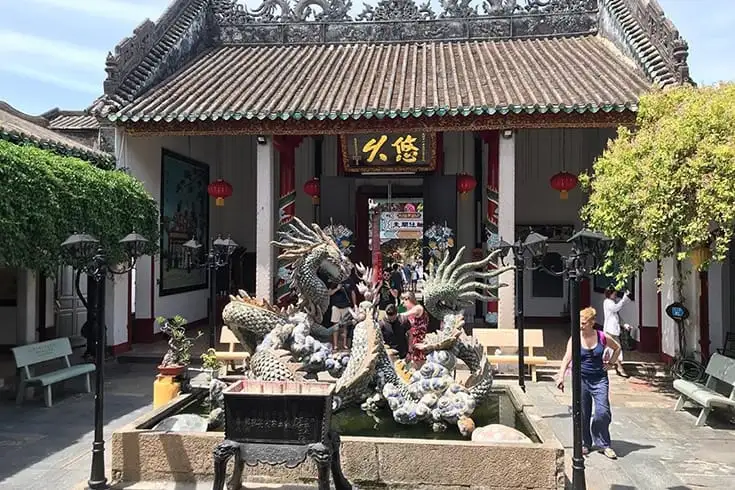
Visitors can explore the temple to admire its elaborate interior, participate in local rituals, or quietly sit in the shaded courtyard for a moment of reflection. The temple is free to enter and is open throughout the day. Walking through the temple, you can feel the spiritual atmosphere and catch glimpses of local devotion, making it a must-visit temple near Hoi An for travelers interested in culture, history, and authentic local practices.
My Son Sanctuary
Nestled in a lush valley about 40 kilometers southwest of Hoi An in Duy Xuyen District, My Son Sanctuary stands out as a truly unique temple near Hoi An.
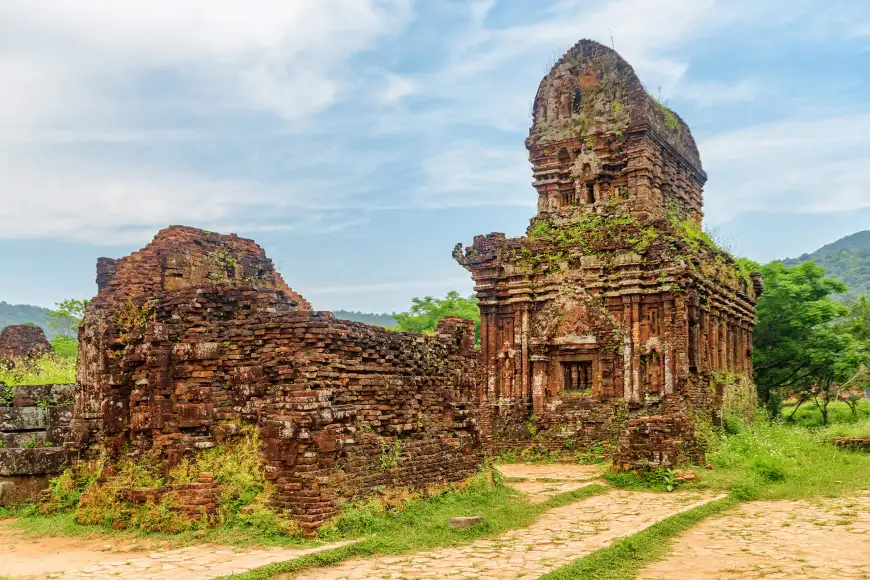
Unlike typical pagodas in town, this ancient Hindu Cham complex consists of dozens of red sandstone towers built between the 4th and 14th centuries, many intricately carved with depictions of deities, mythical creatures, and sacred rituals. The towers are scattered among dense forests and gentle hills, creating a mystical atmosphere that feels both secluded and awe-inspiring.
Visitors can wander along quiet paths, explore the ruins, and imagine the spiritual ceremonies that once took place here. Open daily from 6:30 AM to 5:00 PM with an entrance fee of around 150,000 VND (~$6 USD). My Son rewards those who arrive early with cooler temperatures, softer light for photography, and a peaceful setting to reflect on Vietnam’s ancient Cham heritage.
Phuc Kien Assembly Hall
Located on Tran Phu Street in Hoi An Ancient Town, Phuc Kien Assembly Hall, also called the Fujian Chinese Assembly Hall, is a lively cultural and spiritual hub reflecting the legacy of Hoi An’s Chinese merchant community. Its elaborate roof with dragons and phoenixes, richly decorated altars, and intricately painted wooden panels captivate all who enter.
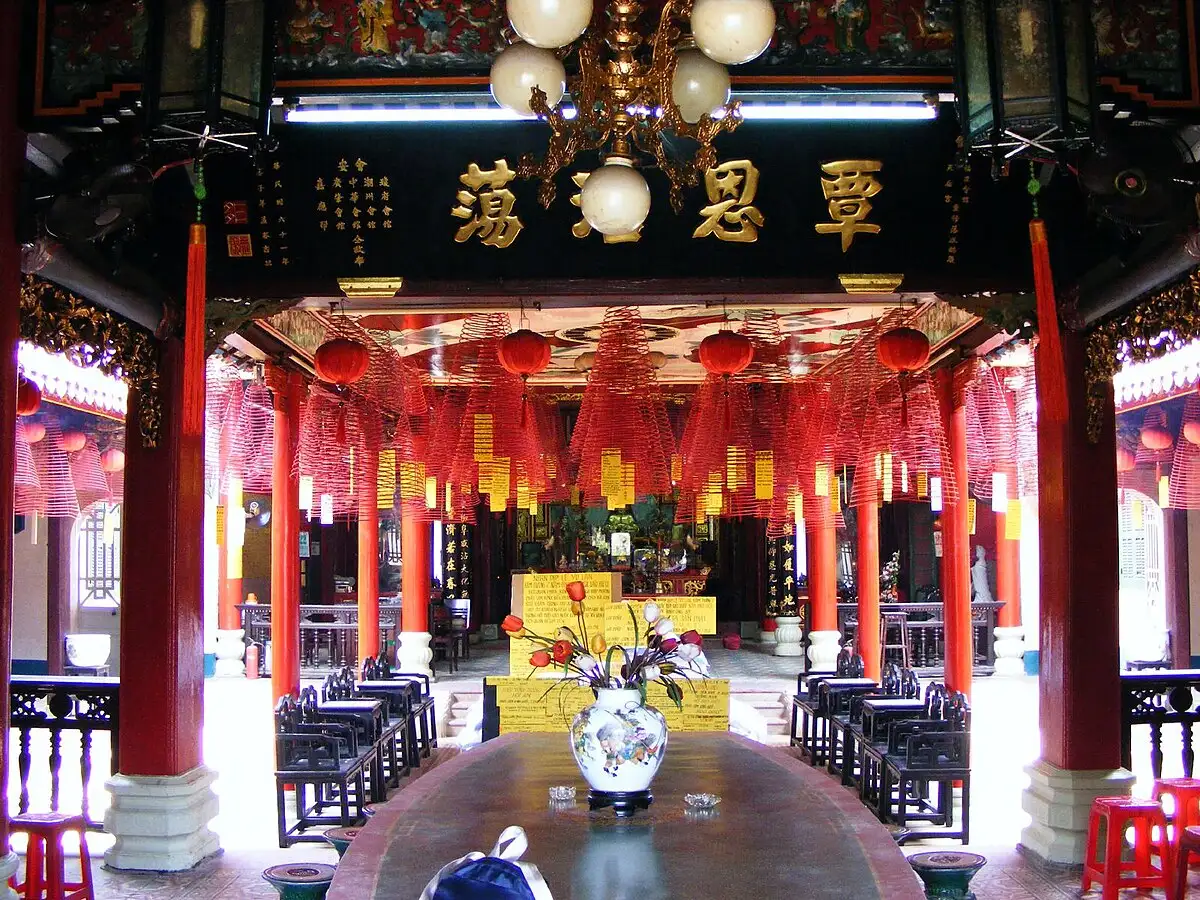
Strolling through the courtyard reveals intricate details of the craftsmanship, and observing local worshippers during their rituals immerses visitors in the community’s spiritual practices. Open daily until early evening with free entrance, the hall offers vibrant photo opportunities and occasional cultural performances, providing an authentic glimpse into Hoi An’s historic life.
Chuc Thanh Pagoda
Just a short walk from the bustling Phuc Kien Assembly Hall, Chuc Thanh Pagoda stands as Hoi An’s oldest pagoda, dating back to the 17th century. Its traditional wooden structure, elegant tiled roof, and intricately carved altars showcase classic Vietnamese Buddhist architecture, offering a peaceful retreat amid the lively streets.
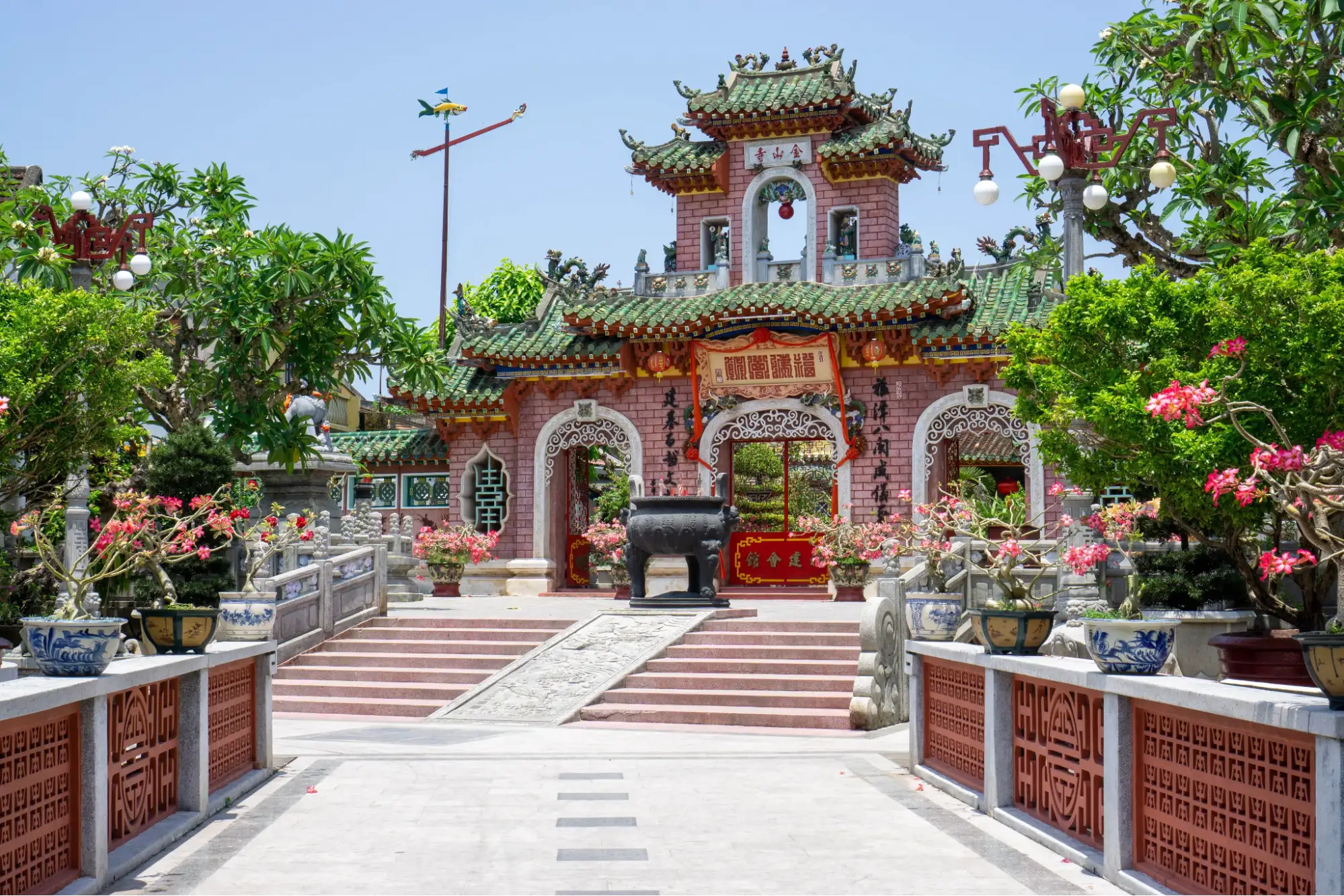
The towering bell and spacious courtyard invite quiet reflection, while daily rituals performed by resident monks give a genuine glimpse into local spiritual practices. Open all day with free entry, mornings are the best time to enjoy meditation, photography, or simply soak in the tranquil atmosphere of this historic temple near Hoi An.
Phap Bao Pagoda
Phap Bao Pagoda, tucked behind the colorful lanes of Hoi An Ancient Town, exudes a tranquil charm that contrasts with the bustling streets nearby. Built in the 18th century, it features a serene courtyard, an elegantly tiled roof, and intricate wooden carvings illustrating traditional Buddhist stories.
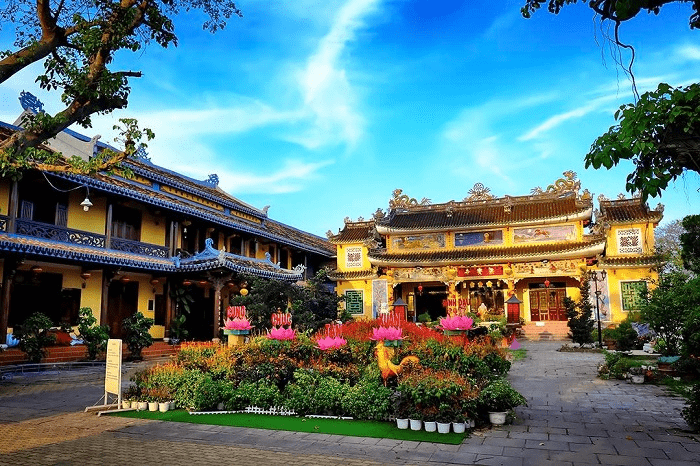
According to local legend, the pagoda was founded to honor a devoted monk whose meditation here was believed to bring protection and blessings to the town. Visitors may wander through the courtyard, admire the detailed altar, or join in quiet prayers with the resident monks.
Open daily with free entry, early mornings offer the calmest atmosphere and soft light perfect for photography. With its peaceful ambiance and rich cultural history, Phap Bao Pagoda stands as a memorable temple near Hoi An.
Ba Mu Temple
Hidden along a quiet lane near the Thu Bon River, Ba Mu Temple is a small yet historically significant shrine that attracts both locals and curious travelers. Known for its distinctive three-tiered roof and finely carved wooden panels, the temple honors local deities believed to protect fishermen and the surrounding community.
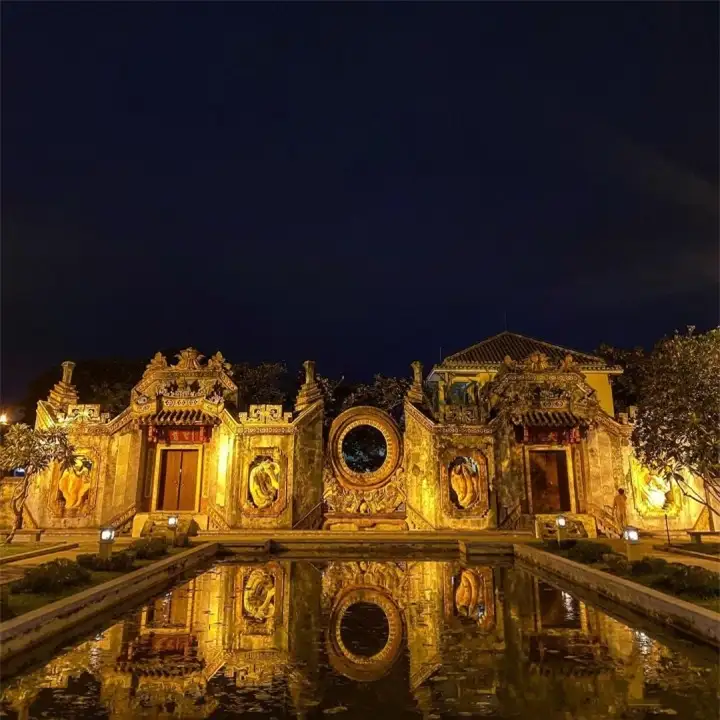
A local legend tells of a fisherman who once discovered a sacred statue at this site, leading to the temple’s establishment and its ongoing spiritual importance. Visitors can admire the detailed carvings, join in morning prayers, or simply enjoy the serene riverside atmosphere. Open daily with no entrance fee, the temple provides a peaceful spot for reflection and photography.
Cam Pho Temple
Cam Pho Temple, also known as Cẩm Phô Communal House, is a historic spiritual site located at 52 Nguyen Thi Minh Khai Street, Cam Pho Ward, Hoi An. Built in the 15th century and restored in 1817 and 1897.
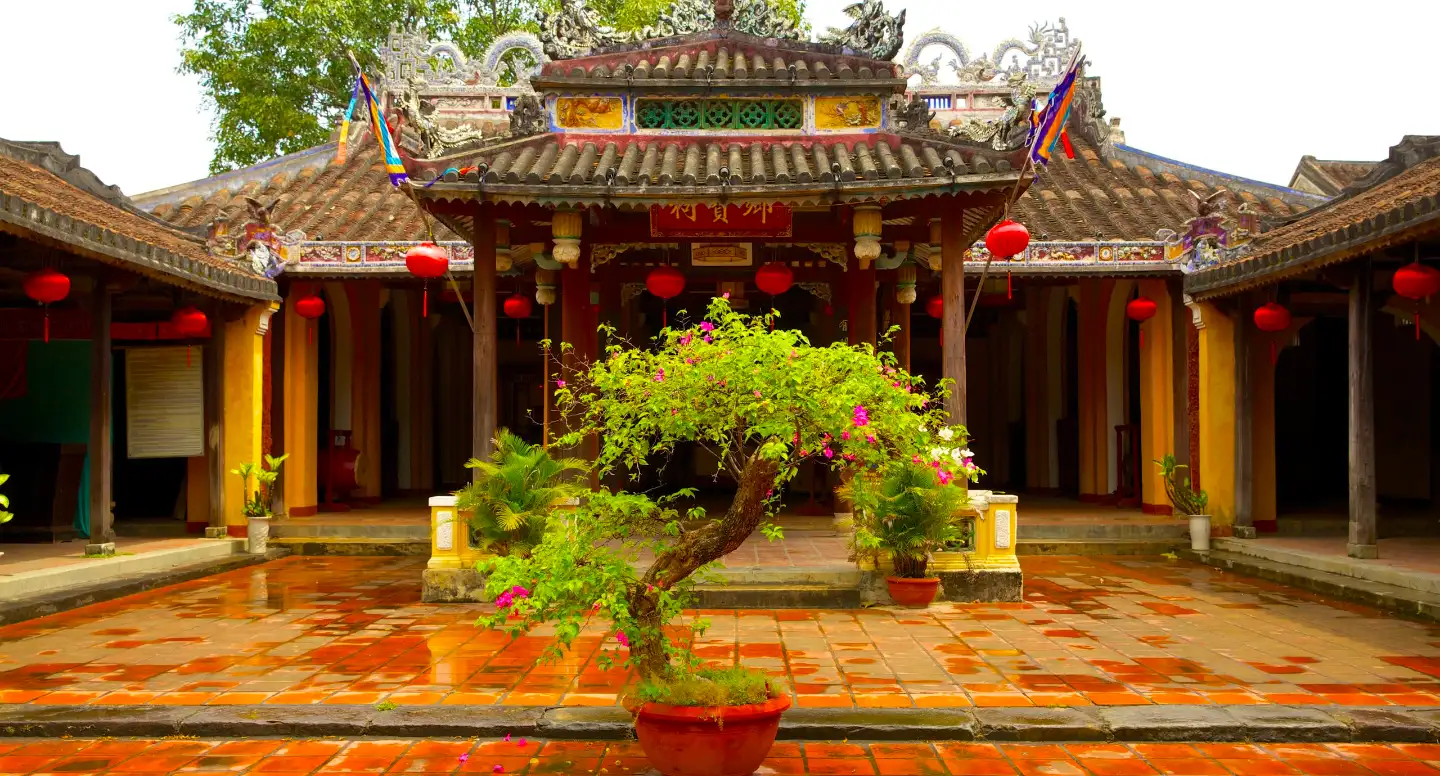
This temple showcases a blend of Vietnamese and Chinese architectural styles, featuring intricately carved wooden doors, colorful roof tiles, and a serene courtyard lined with bonsai trees. Situated near the iconic Japanese Covered Bridge and Hoi An Central Market, it’s easy to include Cam Pho in a walking tour of the Old Town.
The temple opens daily from 8:00 AM to 5:30 PM, with an entrance fee of 120,000 VND for adults and children over 15, while younger visitors enter for free. Guests can stroll through the tranquil grounds, admire the detailed carvings, observe local rituals, or take photos of the peaceful setting that combines cultural heritage with a quiet retreat from the bustling streets.
Phuoc Lam Pagoda
Phuoc Lam Pagoda, tucked along a quiet street in Hoi An’s Old Town, is celebrated for its serene atmosphere and impressive collection of sacred statues.
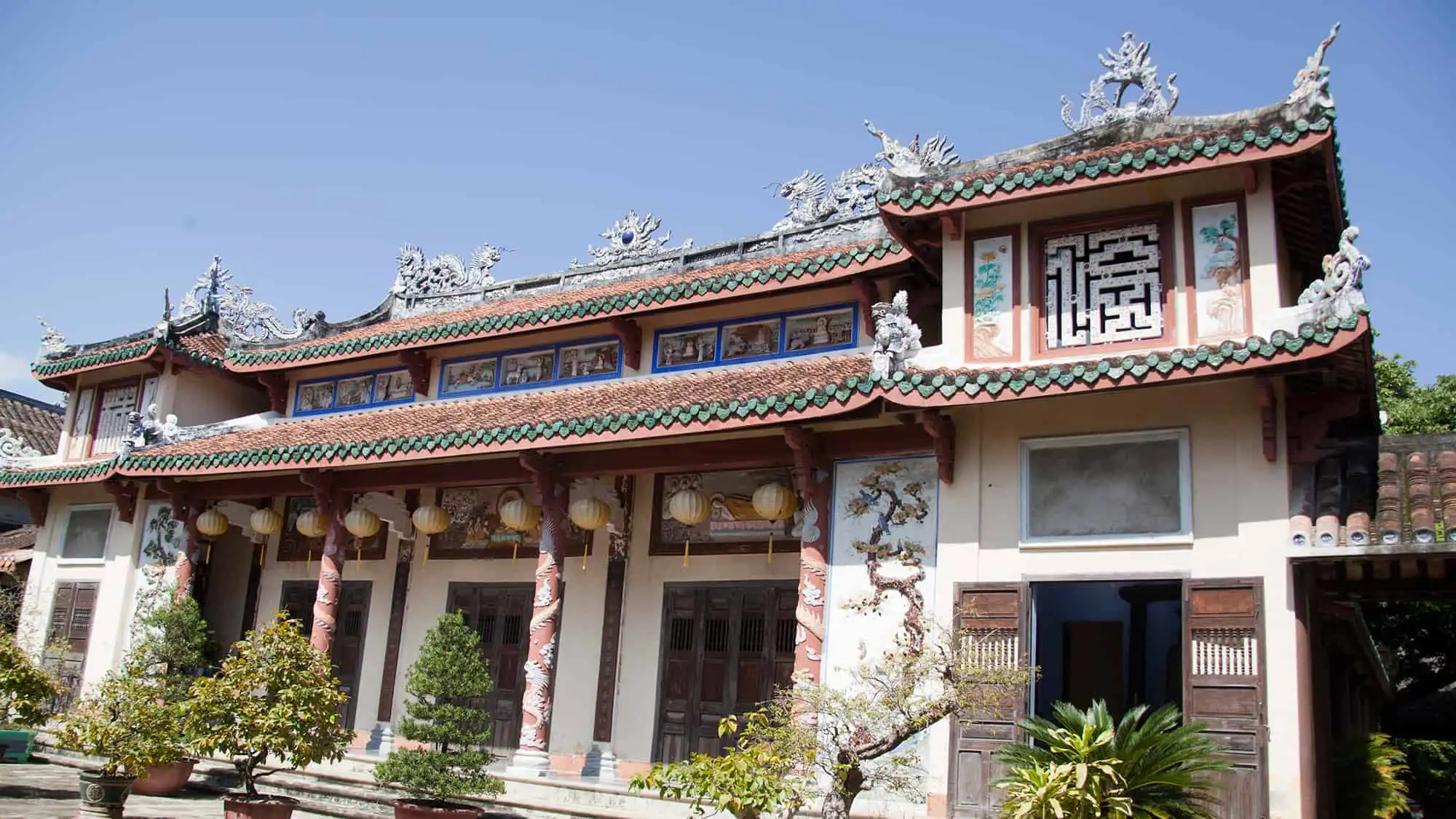
The pagoda features intricately carved wooden altars, a gracefully tiled roof, and a tranquil courtyard.Its true highlight lies in the remarkable Buddhist statues: Quan Âm Nam Hải, Phật nhập Niết Bàn, the wooden Chuẩn Đà, a large bronze bell, and most notably, the rare 7th-century stone statue of Vishnu, the Hindu deity who preserves the universe.
Long serving as a spiritual center for local devotees, the pagoda is especially peaceful in the early morning, perfect for meditation, photography, or quietly observing the daily rituals of resident monks. Phuoc Lam Pagoda is a must-visit temple near Hoi An for anyone seeking both cultural richness and spiritual insight.
Hai Tang Pagoda
Perched on Cu Lao Cham Island, Hai Tang Pagoda is a serene spiritual sanctuary that has stood since 1758. Located in Bai Lang village, Tan Hiep commune, the pagoda reflects a unique blend of Buddhist and local islander traditions, honoring both Buddha and regional deities.
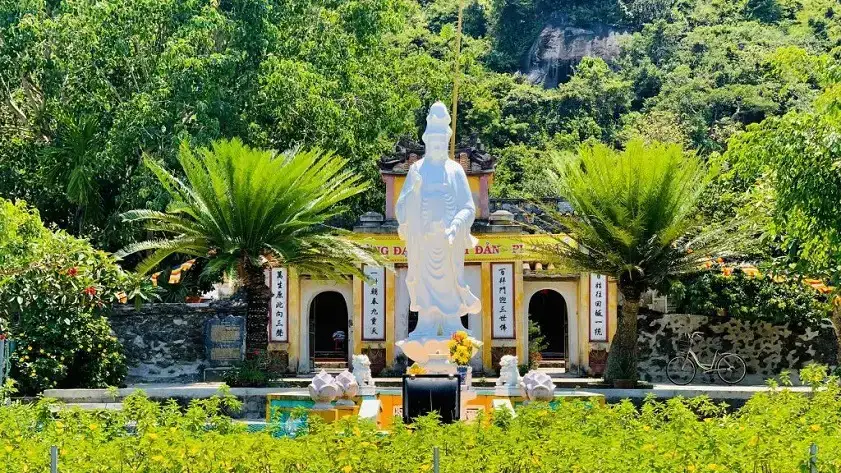
Its striking red-tiled roof, yellow walls, and spacious garden create a tranquil setting, while the majestic statue of Quan Am at the front of the temple inspires reverence and contemplation. Visitors can reach the pagoda by boat from Cua Dai Beach, taking about 1.5 hours by traditional boat or 30 minutes via speedboat.
Once there, guests can explore the historic architecture, enjoy the peaceful surroundings, participate in daily rituals, or take in the stunning coastal scenery. With nearly 300 years of history, Hai Tang Pagoda remains a must-visit temple near Hoi An for those seeking cultural depth, spiritual insight, and a connection to the island’s heritage.
Vien Giac Pagoda
Vien Giac Pagoda, nestled at 34 Hung Vuong Street, Cam Pho Ward, Hoi An, is a historic temple that has stood since 1841. Originally known as Cam Ly Pagoda and first built in Xuyen Trung (Cẩm Nam Ward), it was relocated to its current location after a landslide caused by heavy rains.
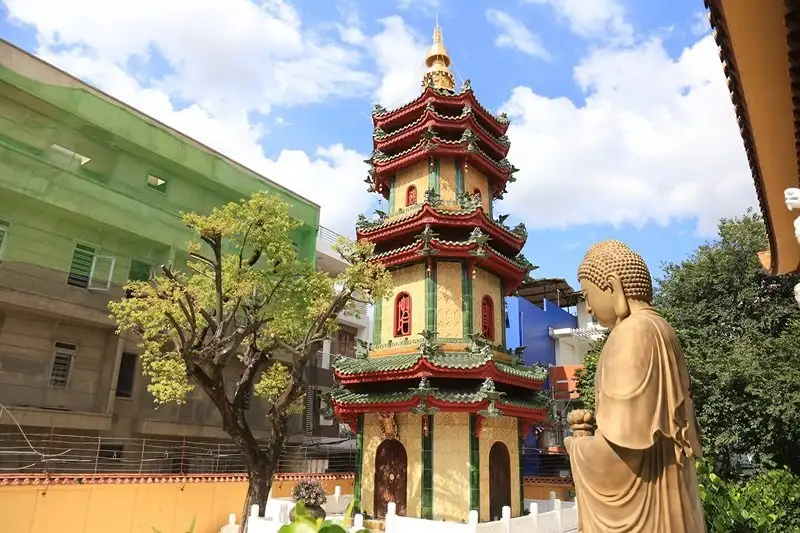
The temple features classic East Asian architecture, with a red-tiled roof, yellow walls, and a spacious courtyard that radiates tranquility. A highlight of the pagoda is the Dang Quang ceramic tower, decorated with exquisite porcelain patterns that showcase a blend of traditional craftsmanship and artistic creativity.
Visitors can wander the serene grounds, admire the intricate architectural details, participate in local worship rituals, or simply enjoy quiet contemplation. Open daily, Vien Giac Pagoda offers a peaceful retreat and remains a notable temple near Hoi An for travelers seeking both cultural insight and spiritual calm.
Van Duc Pagoda
Van Duc Pagoda, located in Dong Na Village, Cam Ha Commune, Hoi An, is one of the town’s historic and revered temples, founded in the late 17th century by Zen master Minh Luong. Its name, “Van Duc,” reflects the aspiration to accumulate boundless merit, and the temple has long been a spiritual center for local devotees.
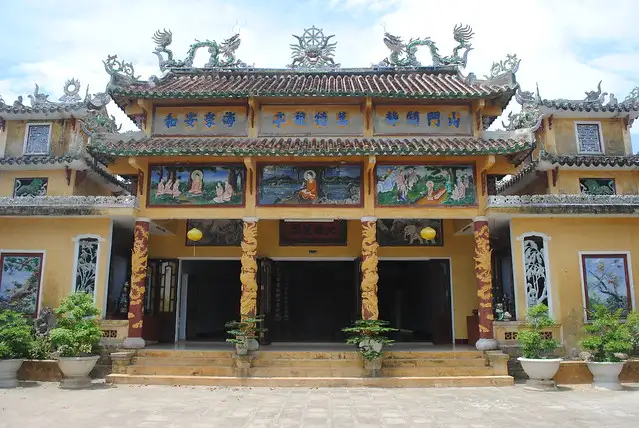
The pagoda showcases traditional East Asian architecture with elegantly curved roof tiles, richly decorated dragons, phoenixes, lions, and lotus motifs, all set within a spacious, tree-lined courtyard that invites quiet contemplation. Inside, visitors can admire precious Buddhist statues, a large bronze bell, stone steles, and the remarkable collection of 115 woodblock Buddhist scriptures, some dating back to 1482.
Throughout the year, Van Duc Pagoda hosts major Buddhist festivals, including Vesak, Vu Lan, and Tet, when worshippers release lanterns on the nearby De Vong River, creating a mesmerizing and spiritually uplifting atmosphere. Open daily from 8:00 AM to 5:00 PM with free entrance, perfect for those seeking both spiritual reflection and a deeper understanding of the region’s Buddhist heritage.
Quan Am Pagoda
Quan Am Pagoda, located at 13 Nguyen Hue Street, Minh An Ward, Hoi An, is one of the oldest Buddhist temples in the town, with origins dating back to before 1653. Originally built by the residents of Minh Huong Village, it was later relocated to its current position behind the Quan Cong Temple in the early 20th century.
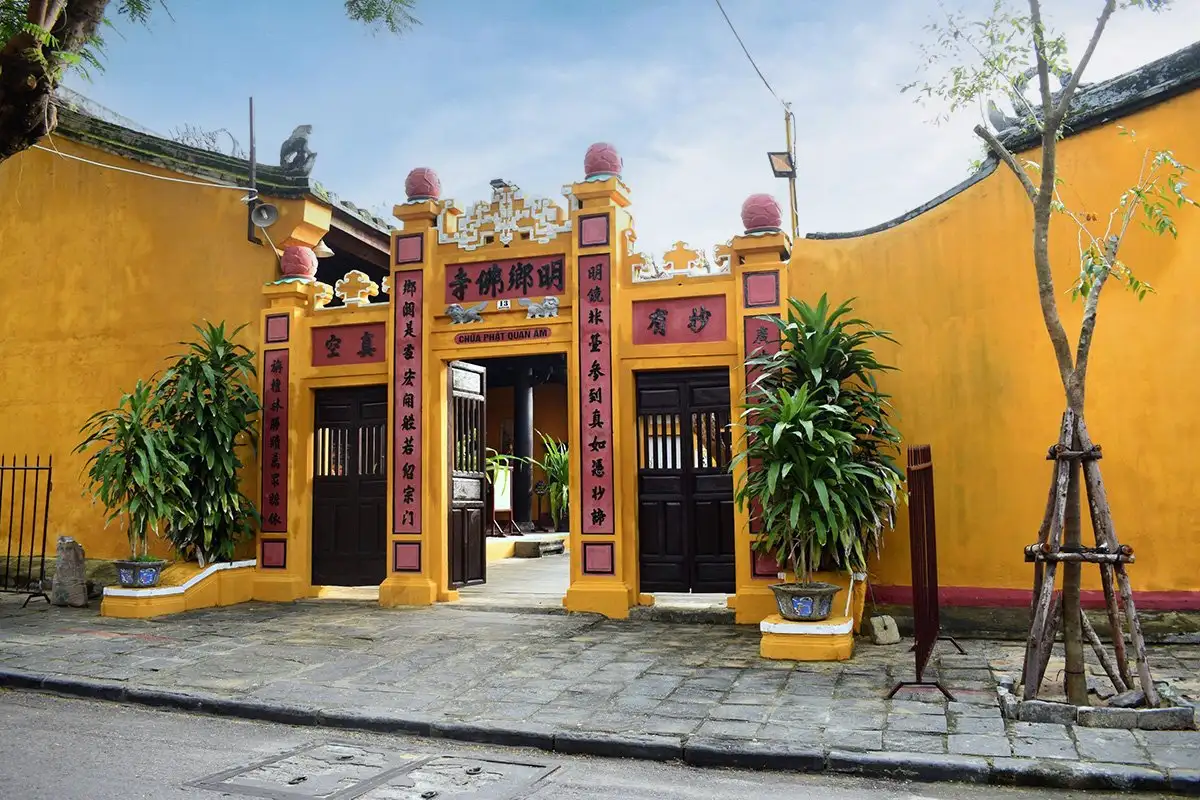
The pagoda is recognized as a national historical and cultural relic, reflecting the rich spiritual heritage of Hoi An. The architecture of Quan Âm Pagoda showcases traditional East Asian design, featuring wooden beams, columns, and intricate carvings crafted by skilled artisans from the renowned Kim Bong carpentry village.
The main hall is solemnly arranged with a central Buddha statue, flanked by altars dedicated to Bodhisattva Avalokiteshvara and other deities, creating a serene and contemplative atmosphere. Visitors to the pagoda can experience the peaceful ambiance, admire the detailed craftsmanship, and participate in local worship rituals.
Hy Hoa Temple
Hy Hoa Temple, located at 6 Nguyen Thai Hoc Street, Minh An Ward, Hoi An, is a spiritual sanctuary that honors the Five Elemental Immortals, revered in Vietnamese folk beliefs.
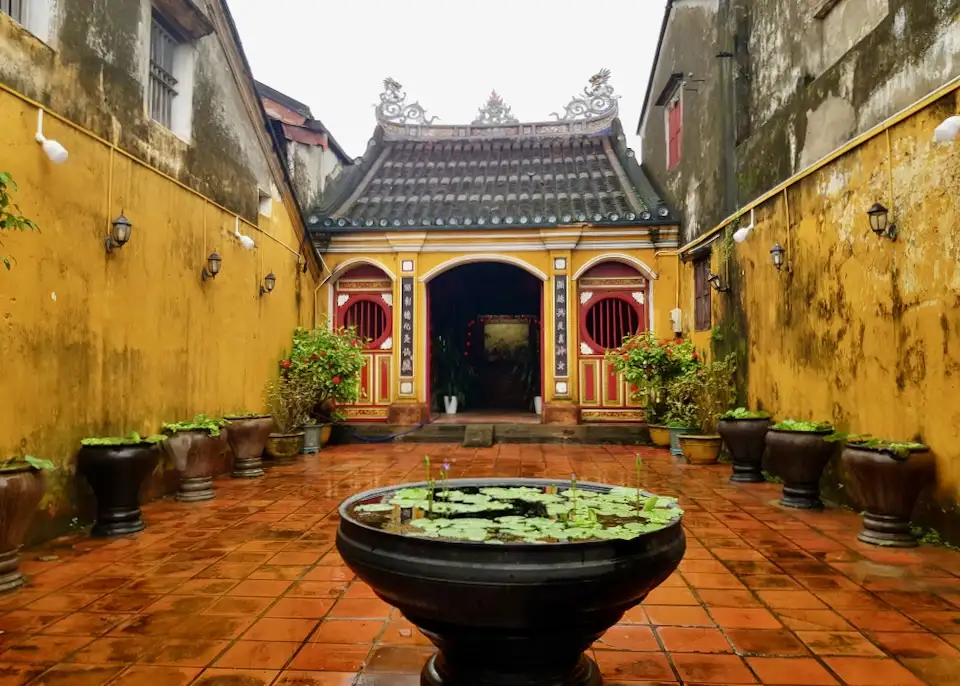
The temple’s architecture reflects traditional Vietnamese design, with a wooden structure adorned with intricate carvings and decorative elements. Inside, visitors can observe altars dedicated to the Five Elemental Immortals, each representing a fundamental aspect of existence. The serene atmosphere provides a peaceful retreat from the bustling streets of Hoi An.
While not as widely known as some other temples in the area, Hy Hoa Temple holds significance for those interested in exploring the diverse spiritual practices that have shaped Hoi An’s history. Its location near other historical sites makes it a convenient stop for travelers seeking to deepen their understanding of the town’s cultural landscape.
Nam Quang Pagoda
Nam Quang Pagoda, located at 36-430 Cua Dai Street, Cam Chau Ward, Hoi An. Stands out among the many temples near Hoi An for its striking architectural style inspired by Thai and Cambodian design. Founded in 1969 by Venerable Gioi Nghiem, the temple underwent a major restoration between 2005 and 2011 under the guidance of Venerable Phap Cao, transforming it into one of the most unique spiritual landmarks in the region.
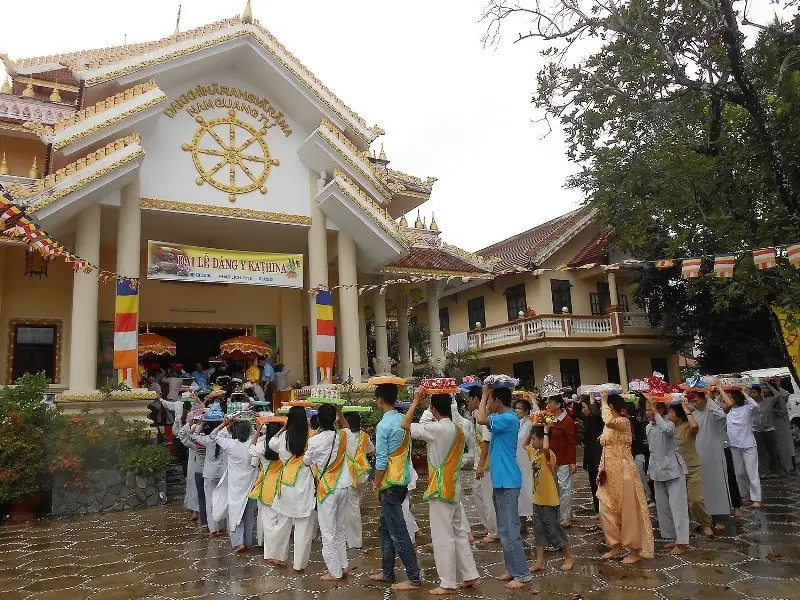
The spacious main hall, covering over 500 square meters, is adorned with colorful motifs and elegant pillars, while a two-story monks’ residence adds to the temple’s grandeur. Inside, the solemn atmosphere invites visitors to pause, reflect, and admire the blend of Southeast Asian influences rarely seen in central Vietnam.
Travelers often find Nam Quang Pagoda an inspiring stop, whether for quiet contemplation, photography of its unusual design, or learning more about the diverse spiritual traditions that enrich Hoi An. Thanks to its location just outside the ancient town, the temple is easily accessible by bicycle or motorbike, making it a convenient addition to a day of cultural exploration.
Travel tips for visiting temple near Hoi An
Visiting temples near Hoi An is a chance to connect with the town’s spiritual traditions while enjoying its serene cultural landmarks. To ensure a respectful and fulfilling experience, keep these practical tips in mind:
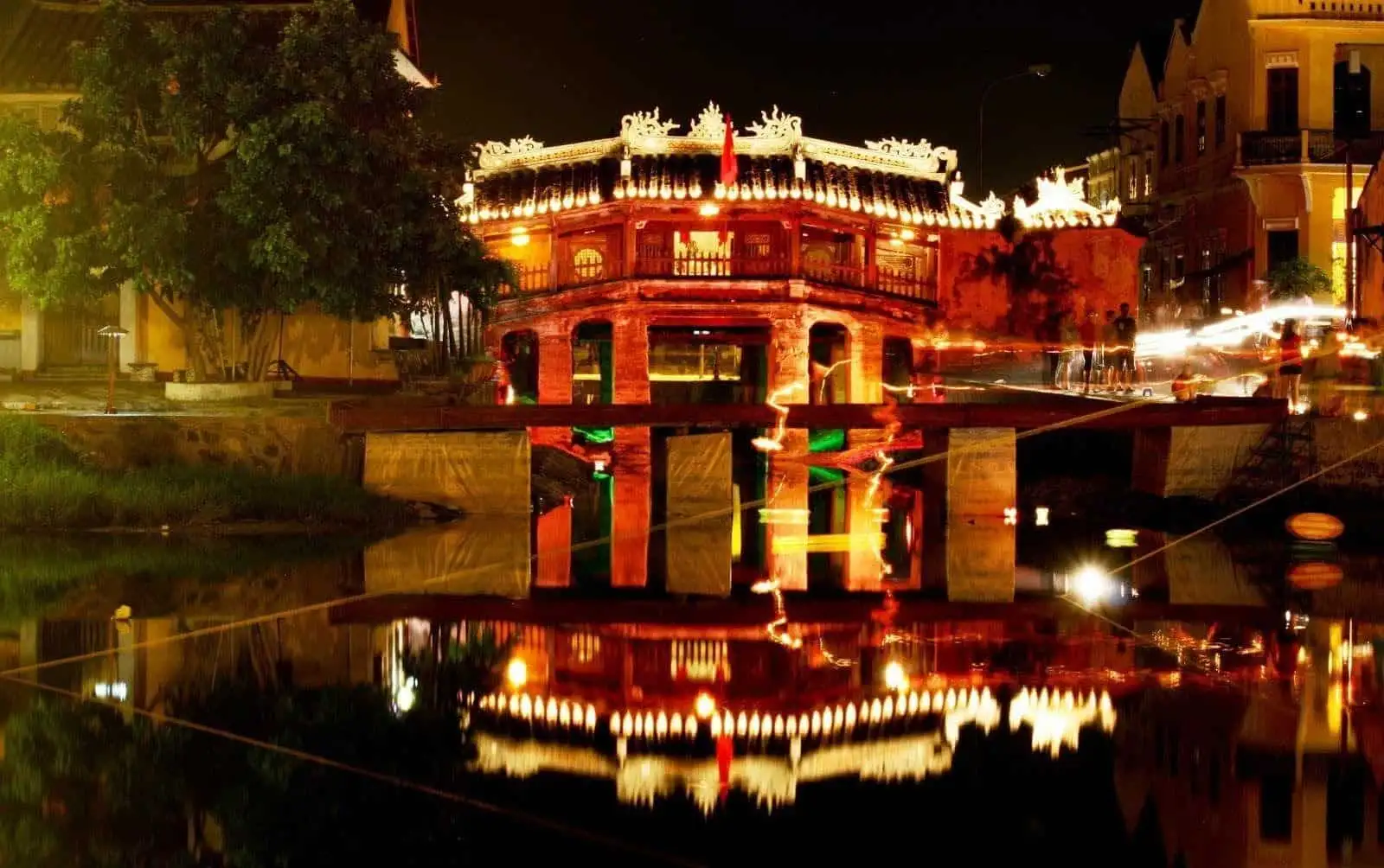
Travel tips for visiting temple near Hoi An (source: BDATrip)
- Best time to visit: Early morning (7:00-9:00) or late afternoon (16:00-17:30) offers cooler weather, softer light for photography, and fewer crowds.
- Dress code: Wear modest clothing that covers shoulders and knees. A light scarf is handy if you plan to visit multiple temples.
- Footwear: Choose shoes or sandals that are easy to slip off, as most temples require visitors to remove them before entering the main halls.
- Entrance fees & donations: Most temples are free, but small cash donations are appreciated and help with upkeep.
- Getting around:
- Temples in Hoi An Ancient Town are easily reached on foot or by bicycle.
- Sites further out, such as My Son Sanctuary or Nam Quang Pagoda, are best accessed by motorbike, taxi, or a guided tour.
- Etiquette: Keep your voice low, avoid pointing directly at Buddha statues, and always ask before taking photos inside prayer areas.
- Experiences to try: Join a chanting session, light incense, or simply sit quietly in the courtyard to soak in the atmosphere.
- What to bring: Drinking water, sun protection, and mosquito repellent if you’re heading to pagodas in the countryside.
Taking a little time to prepare makes your temple visits not just smoother, but also more meaningful. With respect, curiosity, and an open heart, exploring these sacred spaces can become one of the most rewarding highlights of your journey in Hoi An.
Hopefully, this overview of Hoi An’s sacred sites has given you both inspiration and a clearer idea of where to go. Each temple holds its own atmosphere, story, and traditions, offering a unique layer to your journey through this historic town.
A day spent exploring the temples near Hoi An will leave you inspired, yet longing for a place to restore your energy. Imagine ending your journey not in the bustle of the city, but in a beachfront haven where every sunrise feels like a new beginning.
That’s exactly what awaits you at Bliss Hoi An Beach Resort & Wellness – a sanctuary where culture, comfort, and the ocean meet. After a day wandering through sacred halls and tranquil courtyards, you can return to oceanfront views. From indulging in spa rituals to savoring gourmet cuisine with sea views, every detail is crafted to turn your stay into a once-in-a-lifetime experience.
Book your stay and let your Hoi An journey be remembered not only for its temples, but also for moments of true relaxation and rejuvenation.








